Alenka Pirman
Diligent in Time and Space
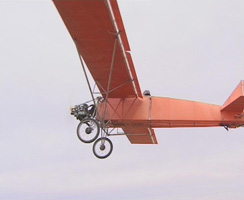 All
you need is a desire for a better life and a willingness to work for it.(1)
All
you need is a desire for a better life and a willingness to work for it.(1)
Joost Conijn is a 29 year old Dutchman, who likes to travel. Even more - he likes to construct his vehicle by himself. Last year, for instance, he spent several months constructing a plane, which he later on exhibited on the De Fabriek roof in Eindhoven. Then he took his plane to the Sahara desert where he also tried it out. Joost Conijn is an artist. With the aid of his co-workers he filmed the entire procedure - from making the plane, the trip to Morocco and the flight in the desert - and made a 28 minute video documentary Airplane. We were able to see this documentary on the large screen in the Modern Gallery.
Paavo Rahkonen is a 69 year old American of Finish origin, who has had a wish to leave Earth already for two decades. He dedicated his eremitic life to the preparations for the flight into space. He developed projectiles and rocket fuel and at the latter he also co-operated with NASA. The development of space technology overtook him, for in the year man stepped on the moon for the first time, Rahkonen realised that he had failed. Paavo Rahkonen is not an artist. His story was filmed on video (30 minutes) by the Finnish artist Veli Granö who entitled his work A Strange Message from Another Star. We watched this on the television set at the International Graphic Art Centre.
AWAY!
Already the desert forefathers
thought of the society as ‘ship, which was wrecked and from which every
individual must swim in order to save his life. These men were certain
that passive receiving of norms and values of the society in which they
lived and giving into these norms and values is a complete disaster.’(2)
‘I grew up during the World War. People just killed each other as much
as they could, bullets, bombs. Whole cities and families destroyed ...
Mom and Dad were constantly arguing. So I thought that the World was filled
with hatred and war, that's how I grew up ... It was 1945. I was on my
way to school on the subway. People were carrying newspapers, and the
New York Daily News headline said: ‘Atomic bomb dropped on Japan’ The
whole city was destroyed. I thought now the crazy people, who ascended
from the apes had invented a way to murder all the people on the earth
... If I only could find another planet in space where human beings could
live in peace, I'd go there,’ is explained to us by Paavo.(3)
After the realisation the moment
of decision arises. Conijn and Rahkonen are linked by the decision for
hard ascetic work, which is based on their own ingenuity and only rarely
on the help ‘from the outside’. Both of them tried out their experiments
and constructions in the desert and both of them used epic periods of
time in order to perform this task.
But, if we have neglected
the penetration into the causes of the phenomenon, which we can already
for millennia call the ‘shipwreck of humanity’ to our benefit, we can
just as easily neglect the causes why people ‘swim’ in one way or another
(let’s say according to Merton’s scale of five possibilities(4)). Let’s
rather continue with the astonishment as regards the ‘uncontrolled’ (as
stated by Conijn) aspiration, which leads our heroes into pioneer actions:
Conijn to produce transportation vehicles for months and months and then
travel with them and Rahkonen who, in his youth, swore in front of the
mirror ‘space is your life story’ and then obsessively developed rocket
fuels for the next two decades.
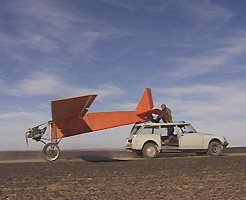
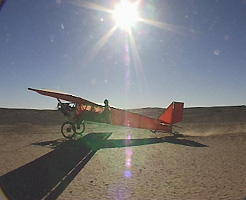 Joost
Conijn: Airplane, 2000
Joost
Conijn: Airplane, 2000
GRAVITATION
Paavo was rejected by his father,
who told him that his plan was ludicrous, for ‘ no-one
could leave the earth. We were meant to stay down here, gravity keeps
us here.’ The stories of Conijn and Rahkonen were divided in time and
space until Manifesta 3 - and yet they are linked by a similar ‘life plan’
(Cohen(5)). Even more! Both have decided to beat two forces: gravity
and fatalism.
In this, they are of course by no means alone. Many individuals and organizations
from the world of sport, politics, art and science have proven that conquering
the aforementioned forces is the key to fulfilling various aspirations.
To illustrate this fact we will, at this point, state some cases from
domestic writings and books:
- Let’s take for instance
mountaineering. Regardless of the specific field all have one thing in
common:
to climb up, which means:
reach the goal and fulfill the desire, which is present in every individual
in one way or another’(6). On the other hand dr. Klement Jug believed
that ‘true mountaineering deals with the strengthening of character, which
… anyway demands that a cultural human being should substitute his obedience
with courage, dedication for his fellow mates, loyalty, rejection of comfort
and other pleasures as well as self-indulged discipline.’(7)
- On the day when Apollo 12
landed on the moon and Rahkonen experienced his first epileptic seizure,
a group of enthusiasts in Ljubljana established the Astronaut Rocket Club
Vladimir M. Komarov. Members started with ‘independent constructing of
rocket models and space crafts. At first more oriented towards experimenting
and testing various … rocket and space craft models, our rocket model
constructors soon started participating in sport rocket model launching.’(8)
The club is dedicated to bringing the human conquest of space to the ordinary
man on the street and at the same time they are taking care that Slovenia
stays in touch in these endeavors.(9)
- On 20th April 1961
John F. Kennedy sent a memorandum to his vice-president with which he
‘set in motion the complicated and hard working machinery of federal decision
making, which at the end enabled USA to send a man to the moon and spend
over US$ 25 billion of taxpayer’s money…(10) Conquering space therefore
officially became the prestige training ground of the cold war, a propaganda
battle between two social structures. Rahkonen’s plan was thus overtaken
by the country in which he lived. However NASA employed him, so that he
could develop the fuel which was later on used for the space shuttle.
- However, conquering space
can not be a privilege of world (super)powers. Therefore it leaves an
open gap (in the technological as well as in the economic and political
sense), which was temporarily filled by an attempt of a private, commercial
initiative started by the German Lutz Kaiser. In 1971 Kaiser planed an
innovative low budget project to construct simple launching rockets which
was partially funded by the state. After the funding was cut off, Kaiser
established a joint-stock company OTRAG (Orbital Transport und Raketen
AktienGesellschaft) which operated in the period between 1974 and 1987.
They performed five trial launches in three different countries (Zaire,
Libya and Sweden) which one by one cancelled their contracts under the
pressure of USA or USSR (OTRAG was discredited with the supposition, that
this was in fact a way of developing a secret German weapon).
- Can the emancipation of an
individual country truly be measured also by its attitude to conquering
space? On 8th June 1998, under the supervision of engineer
Marko Peljhan, the Pocket-Size State of the Scarecrows (located
in Ljubljana) launched their rocket - Monolit. The rocket - which
was constructed by two young constructors from ARK Vladimir M. Komarov!
- failed to open its parachute after its take-off and it therefore landed
in a treetop three gardens away. This fact, however, did not discourage
Milena Kosec, a state official, who called the launch a success - for
they achieved ‘Frightening on a higher level’. Defying gravity (and potential
colonization) can by all means be understood as one of the freedoms of
the state.(11)
- And this is not all! The representatives
of the Association of Autonomous Astronauts (AAA) add: ‘Every man and
every woman is an autonomous astronaut!’(12) AAA is ‘the world's only
independent, community-based space programme’ which will supposedly develop
their own space crafts and leave this planet. The rhetoric of the movement
is directed against corporations and state ruled space agencies.(13) However,
not anybody can be an autonomous astronaut, for ‘What is the point of
going into space if all you do is replicate the same conditions that prevail
on planet earth? You know, what is the point of, for example, going to
the moon if all you do when you get there is visit a McDonalds?’(14) Well,
Rahkonen could by all means be seen as the avant-garde of the AAA movement,
even though it holds true that his current forte is not hard construction
work, but well thought out rave parties.(15)
- Nevertheless, the human body
should not be left to chance in a zero gravity environment. On 15th
December 1999, on a plane IL-76MDK almost 7 kilometers high a modular
action took place within the frame of the project Bio-mechanics Noordung(16)
(by the way - an AAA representative was present as an observer in the
plane). The dramatic series was based on algorithm equations and simulations
of the expansion of a porous block of spongy bone tissue in the conditions
of micro gravitation (already on the Russian space station Mir they have
dealt with studying the accelerated loss of calcium in the zero gravity
environment). At this point we should neglect the ‘mythic mass Noordung’(17)
and draw attention to the fact that Dragan ®ivadinov and Peljhan’s Association
Project Atol, who produced the project also started the initiative for
establishing the Slovene Space Agency (which should ‘join knowledge with
political power and capital, with the aim to establish conditions for
the operation of Slovenia in the integration processes in real cosmos’)(18)
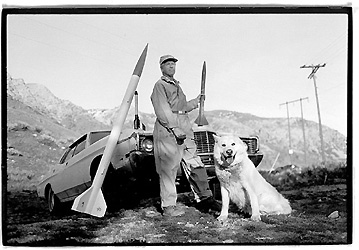 Veli
Grano: A Strange Message from Another Star, 2000
Veli
Grano: A Strange Message from Another Star, 2000
PIONEER SPIRIT
But, as already stated, let’s
be amazed. Our heroes started with their enterprises by themselves, ‘amateurishly’,
disregarding the problems that are (im)possible to overcome. ‘If I want
to fly, I start constructing an airplane and I do not ask myself any questions’(19),
is stated by Conjin, who also likes to add: ‘Anyone can make a plane!’
They also did not pay
any attention to the authorities in this field. Conjin, for instance,
did not wish to have a lot to do with professional constructors, for they
‘anyway just discourage you.’
In the time when we have
already given the power for research and development of this civilization
to appropriate institutions and individuals with various certificates,
in the time, when science has therefore became impossible to translate
into the everyday language and when there is a huge gap between the scientific
view and common sense(20), ‘ordinary’ people, such as for instance Conijn
and Rahkonen - I am aware that I am recklessny putting both of our heroes
into the same corner - allow themselves conditions for permanent individual
work in the ‘pioneer - experience spirit’ (which of course does not mean
that certain institutions do not invent surprisingly witty gadgets - let’s
take for example the newest super computer at the Institute of Chemistry!(21)).
Anachronistic? Ruthless? Or are we maybe dealing with some sort of adventurous,
yet unobtrusive proto-pioneering without conquering ambitions, somehow
in the style of Big-Heads? (‘Big-Heads are an extremely original people,
they say about themselves: We are curious, but we are not inquisitive.’(22))
When Rahkonen and Conijn they encountered a problem in their life, they tackled the problem in their way, with a tactic that only seemingly fits the encouraging manner of writing in DIY (Do it yourself) books. They did not follow the rules literally and they let themselves be overcome by their own individual enthusiasm. And even though an airplane made of remaining parts of other vehicles and rocket fuel from a home mixture can not be trusted (‘Conijn’s ally states: ‘They do not trust even ordinary planes, let alone a plane which is on its deathbed’) - they work! It is therefore not surprising that Michel de Certeau(23) sees in the ‘common day’ tactics and everyday cunning ingenuity also a poetic dimension.
HARD WORK
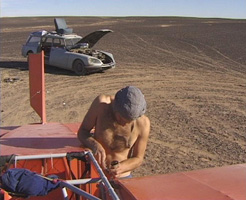
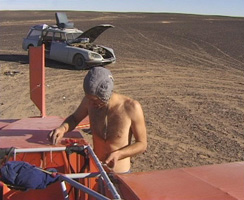 Joost
Conijn: Airplane, 2000
Joost
Conijn: Airplane, 2000
I must confess: I am always overcome by people who perform voluntary hard work, full of relinquish and ravishment.(24) If we are not working, we have time, but it is thought that we are wasting it. We can say something similar also if we are not satisfied by performing our work (we do not have time and yet we are wasting it)(25). Airplane and A Strange Message from Another Star talk about work. About work which is outside the ruling division of time. Conijn and Rahkonen do not perform the described work as a profession (even though at the latter - due to the acute needs on the worker’s market - this also happens for a shorter period of time), but they also do not perform their work in their free time (as a hobby). Their inclination towards ‘ascetic self-discipline’ (Rahkonen for instance admits that he no longer cared for money and love, i.e. the worldly) would be suspicious already to Luther, who introduced the profession (Beruf) as a means for ‘dealing with the given living conditions’.(26) At first glance their work does not seem to be especially profitable (on the contrary) and the results of their work could only conditionally be marked as functional: Conjin’s airplane stays in the air and not really flies (during testing it proved that the pilot can not control the direction of flight and similar) and Rahkonen still lives on the planet he wanted to abandon.
And yet our heroes were successful in their endeavors!
The artist’s flight in Sahara in 1999 is parallel to any successful pioneer flight in the world (let’s say for example with the first, the one performed by the Wright brothers on 17th December 1903 on a beach not far from Kitty Hawk in North Carolina). Today it is of course hard to unnoticeably test an airplane on the hyper-controlled European territory, while in the Sahara ‘people do not notice this’ (even though such activities are also regulated by state regulations in Morocco). The desert is for Conijn ‘an endless territory, freedom’, one could almost say some sort of a private amusement park. Our hero also adds that ‘he experiences the same thrills, regardless of whether he flies 1 centimeter or 30 meters above the ground’. Gravity is defied.
And Rahkonen? Today he would
of course have to change his evacuation plan, for space is being colonized
by the very same people he wanted to run away from. And yet his story
also ends with defying gravity. An explosion in the NASA laboratory left
him with permanent consequences. He had a number of epileptic seizures,
which prevented him from future work. One day when he was at home and
he sadly realized that he had failed, he was visited by the holy spirit,
who took his soul out of his body and took him into the dark sky. This
event was so overwhelming for Rahkonen that he later on stated: ‘Man's
brain hasn't got the capacity to understand how wonderful it is there
where God has come from.’
Hard human work with the goal to defy gravity can therefore be defined
as an alchemist process, at which the primary goal is soon overruled by
the true goal: to force a transcendental experience.
Salvation comes with diligence or it does not exist at all!
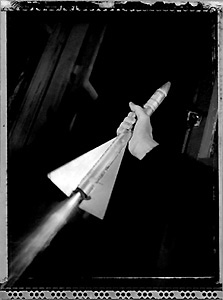 Veli
Grano: A Strange Message from Another Star, 2000
Veli
Grano: A Strange Message from Another Star, 2000
Footnotes and sources:
1.Handbook for
Space Pioneers, Prepared by L. Stephen Wolfe and Roy L. Wysack, Westbridge
Books, Newton Abbot, 1979, p. 3.
2. The Wisdom of the Desert, New Directions Publishing Corp., New
York, 1960, p. 3 (from: Henri J. M. Nouwen: Pot srca. Puąčavska duhovnost
in sodobno oznanjevanje, ®upnijski urad Ljubljana -Dravlje 1992, p.
11.).
3. Manifesta 3 - European Biennial of Contemporary Art, Ed. Igor
Zabel, Cankarjev dom, Ljubljana 2000.
4. In his text 'Social Structure and Anomaly', published in 1938, Robert
Merton for the first time gave forth his theory, which he marked as 'the
doctrine on the socially conditioned iniquity'. He starts from the hypothesis
that social structures perform a certain pressure upon the people in society,
due to which they are more predisposed for a declinatory behavior than
conformistic. Even though this theory is not a 'popular' criminologic
perspective already since the 1960's, it fascinates with the schematization
of five possible adjustment patterns for anomaly pressures: 1. Conformity
(an individual accepts the cultural goals and institutionalized means)
2. Innovativity (an individual accepts the cultural goals but rejects
the institutionalized means). 3. Ritualism (an individual rejects the
cultural goals and accepts the institutionalized means); 4. Escapism (an
individual rejects the cultural goals and the institutionalized means);
5. Rebellion (an individual rejects the cultural goals and institutionalized
means - and at the same time he adopts (defines) new goals and means).
Merton points out that an individual's adaptations are conditioned by
situations and therefore one can transfer from one to another adaptation
variant.
Zoran Kanduč: 'Kriminoloąke teorije strukturnega pritiska' (Criminology
theories of structural pressure), Revija za kriminalistiko in kriminologijo,
Ljubljana, Year 50, No. 1, 1-96, January - March, p. 4.
5. Ibid, p. 6.
6. Milenko Arnejąek - Prle, Plezalni priročnik (Mountaineering
manual), Published by the author, Ljubljana, 1994, p. 5.
7. Dr. Klement Jug, Stena in smrt. Planinčevi zapiski (The rock
and death. Notes by a mountaineer), Karantanija, Ljubljana, 1997, p. 8-9.
8. http://komarov.vesolje.net/
9. For example, in 1976, ARC Vladimir M. Komarov started with the production
of 'didactic sets Pionir for a rocket model education of the youth, which
enabled first rocket launches even in the most remote places of Slovenia
and amongst Slovenes abroad.' Amidst the successes, which place Slovenia
also among the nations that are conquering space, is also the badge -
the emblem of the club, which went into space in 1984 with the Russian
rocket, which 'was the first Slovene… object to fly in space'.
10. John Barbour, 'Steps on the moon', associated press - Delo,
Ljubljana 1969, p. 9. The memorandum read as follows: '… 1. Do we have
any chance of beating the Russians at launching a laboratory into space,
make a trip around the moon or to land on the moon with a rocket or to
bring a man to the moon and back with a rocket? Is any other space programme
in existence which promises dramatic results and with which we could win?
2. How much would a programme like this cost? 3. Are we working round
the clock in order to fulfill the current programmes? And if we are not
working round the clock, why not? If we are not working full speed, could
you draft some recommendations in order to speed up the work? 4. Should
we pay special attention to atomic, chemical or liquid fuel, or maybe
even possible to a combination of all three fuels at the construction
of large carrying rockets? 5. Are we trying our best? Is our success satisfactory?…'
11. Alenka Pirman, 'Premagovanje gravitacije' (Defying gravity), Razgledi,
Ljubljana No.13/1116, 24th June 1998, p. 31.
12. 'Moving in several directions at once', The third annual report
of the Association of Autonomous Astronauts, London, 1998, p. 11.
13. 'In the US and Japan, plans are being developed for lunar factories
and hotels ... And who's going to change the sheets in the lunar hotels
and work in the lunar factories? With austerity imposed to deny the working
class the means to build our own spaceships, the plan is that people will
put up with this drudgery as the price to pay for the chance of a voyage
to the moon. It's the same strategy used to colonize the Americas - offer
the dispossessed the hope of adventure and escape, entice then on a ship
to the "New World" and get them to do all the dirty work.' Ibid., p. 5-6.
14. Ibid., p. 14.
15. 'AAA is the world's only space programme which makes technological
issues secondary to our concern with what we will be doing when we form
autonomous communities in space. What interests us about technology is
how a specific technology can be used, and, of course, who gets to use
that technology.' Ibid., p. 13.
16. http://noordung.telekom.si/
17. Valentina
Plahuta, 'Dragan ®ivadinov leti v vesolje' (Dragan ®ivadinov flies into
space), Delo, 18th July 1998.
18. Blaľ Lukan, 'Dogodek bo, četudi ga morda ne bo' (The event will take
place, even if it will not), Delo, 16th November 1999, p. 10.
19. Vanesa Cvahte, Peto prizoriąče: Manifesta 3., part 2.,
TV Slovenija, Ljubljana, 16. 8. 2000.
20. http://on1.zkm.de/netCondition/matrix/zizek.html
21. http://www.mladina.si/tednik/200039/clanek/nt/ and http://arg.cmm.ki.si/vrana/
22. Arkadij and Boris Strugacki, Hroąč v mravljivąču (Beetle in
an Anthill), TZS, Ljubljana, 1986, p. 115.
23. Michel de Certeau, The Practice of Everyday Life, University
of California Press, Berkley, Los Angeles, London, 1988. 24. An extra
example from art: In his house in Hanover Kurt Schwitters constructed
- using various materials - his first Merzbau construction over a period
of sixteen working years (he started in 1920 in the basement).
25. 'This job is not a way to live, it's a way to waste my life. But what
can I do? Starve?' In: Sabotage in the American Workplace. Anecdotes
of Dissatisfaction, Mischief and Revenge, Ed. by Martin Sprouse, Pressure
Drop Press, San Francisco, AK Press, Edinburgh, 1992, p. 14.
26. Max Weber, Protestanska etika in duh kapitalizma (Protestant
Ethics and the Spirit of Capitalism), Studia Humanitatis, Ljubljana, 1988.
For further reading I suggest you turn to the text of a renown artist, which you can find at http://www.guelman.ru/xz/english/XX22/X2207.HTM
(Alenka Pirman - Artist)